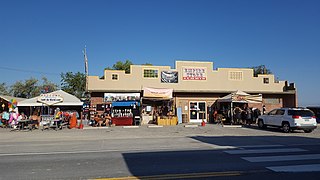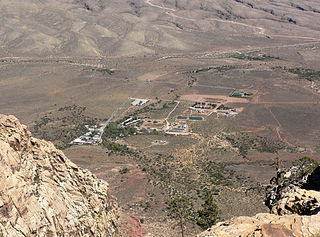
Blue Diamond is a census-designated place (CDP) in Clark County, Nevada, United States. The population was 290 at the 2010 census.

Enterprise is an unincorporated town in the Las Vegas Valley in Clark County, Nevada, United States. The population was 108,481 at the 2010 U.S. Census, up from 14,676 at the 2000 census. It was founded on December 17, 1996. Like other unincorporated towns in the Las Vegas Valley, it uses Las Vegas ZIP Codes for addresses within its boundaries.

Empire is a census-designated place (CDP) and Ghost town in Washoe County, Nevada, United States. The population was 217 at the 2010 census. It is part of the Reno–Sparks Metropolitan Statistical Area; before the 2010 census, it was part of the Gerlach–Empire census-designated place. The nearest town, Nixon, is 60 miles (97 km) to the south on a reservation owned by the Pyramid Lake Paiute Tribe.
Summa Corporation was the name adopted for the business interests of Howard Hughes after he sold the tool division of Hughes Tool Company in 1972. The tool division merged with Baker International in 1987 to form Baker Hughes, the world's third-largest oil-services company.

Hoover Dam Lodge is a hotel and casino near Boulder City, Nevada. It is owned and operated by Richard Craig Estey. It was previously the Gold Strike until it was largely destroyed by an accidental fire on June 16, 1998. It reopened the next year as the Hacienda and then took on its current name in January 2015.

BPB ltd is a British building materials business. It once was a constituent of the FTSE 100 Index. In 2005, the company was purchased by Saint-Gobain of France. The company subsidiary British Gypsum, which was the UK operating arm of the company, operates as a subsidiary of Saint-Gobain, with five manufacturing sites in Britain as of 2012.

Lake Las Vegas in Henderson, Nevada, refers to a 320-acre (130 ha) artificial lake and the 3,592-acre (1,454 ha) developed area around the lake. The area is sometimes referred to as the Lake Las Vegas Resort. It is being developed by 5 companies including Lake at Las Vegas Joint Venture LLC.

Coyote Springs, Nevada, is a master-planned community being developed in Lincoln County and Clark County, Nevada. The community was initially planned by developer and attorney-lobbyist Harvey Whittemore and Pardee Homes. Thomas Seeno and Albert Seeno, Jr. became the sole owners of Coyote Springs following Whittemore's resignation from the Wingfield Nevada Holding Group amidst legal troubles. No homes had been built as of June 2018.
Irwin Molasky was an American real estate developer and philanthropist from Las Vegas, Nevada. He was the Chairman of The Molasky Group of Companies.

Arden, Nevada was an unincorporated community in Clark County, Nevada. The area is now part of the town of Enterprise. Located about 7 miles (11 km) southwest of Las Vegas, the area is experiencing rapid growth in housing development on land formerly owned by the Bureau of Land Management.

Bonnie Springs Ranch was an attraction near Blue Diamond, Nevada that included an 1880s western town replica and a zoo. It is located on 63.86 acres (25.84 ha) in the Mojave Desert, below the Spring Mountains in the Red Rock Canyon area, 20 miles west of Las Vegas. The ranch has natural oasis habitat, from the spring water surfacing there.

Since 2002, there have been various housing proposals for Blue Diamond Hill, located in rural Clark County, Nevada. The proposed site is located west of Las Vegas, near the Red Rock Canyon National Conservation Area. The Blue Diamond Mine has operated on the land since the 1920s, but the property otherwise remains vacant. Each of the proposed housing projects have received opposition from nearby residents and from environmentalists, citing concerns about the impact that such a project would have on the surrounding area.

Blue Diamond Hill is a 4,931-foot (1,503 m) peak that borders Red Rock Canyon in Nevada, west of Las Vegas. The Blue Diamond Mine is located on the hill, and the small community of Blue Diamond, Nevada is located nearby. Several housing projects have been proposed for the hill since 2002.
The White Pine Energy Station was a proposed coal-fired power plant that was to be built in White Pine County, Nevada. The plant was to be built in the county's Steptoe Valley, and would be located 34 miles north of the city of Ely. White Pine Energy Associates, LLC, a subsidiary of LS Power, announced the project in February 2004, with plans to begin construction in 2006, with the possibility of having it operational in 2010. The 1,590-megawatt project would consist of three units, each producing 530 megawatts.

Groom Mine, located in Lincoln County, Nevada, first opened in the 1870s. Most mining in the area, mostly of silver chloride ores, had finished by 1874. Groom Mine continued to operate, finally ceasing operations in 1954. By 1956, official recordings of products of the Groom Mining District, which includes Groom Mine, shows that lead was the bulk of minerals harvested, which also included 145,000 troy ounces (4,500 kg) of silver and about 45 troy ounces (1.4 kg) of gold. During World War II, Groom Mine became surrounded by military activity, which continued into the 21st century. In the 1950s, the mine was exposed to fallout from nuclear testing that was being carried out at the Nevada Test Site. During the late 20th century, military activities, including the destruction of a mill and the restriction of access to the mine, continued to affect work there. The United States Government seized the mine under eminent domain from its previous owners in 2015. Just compensation was set at $1.204 million by the United States District Court, District of Nevada, Judge Miranda Du presiding.
The Moapa Southern Paiute Solar Project is a 250 megawatt (MWAC) photovoltaic power plant located in Clark County, Nevada on the Moapa River lands of the Southern Paiute people. The project was commissioned in March 2017 and was constructed by First Solar and its sub-contractors in close consultation with the Moapa Band of Paiutes and federal agencies. It is the first utility-scale solar project to be located on north American tribal lands, and is anticipated to evolve as a model for similar future economic and environmental partnerships.
Jim Rhodes is an American real estate developer. He founded Rhodes Homes in 1985, and has developed various housing projects in the Las Vegas Valley, including the golf course communities Rhodes Ranch and Tuscany Village. In the 2000s, he was a well known philanthropist in Las Vegas. In 2008, he formed Harmony Homes and began buying distressed properties during the Great Recession. He filed for Chapter 11 bankruptcy in 2009, and turned over most of his residential projects to creditors.

Rhodes Ranch is a master-planned community and golf course located in Spring Valley, Nevada, approximately six miles southwest of the Las Vegas Strip. It was developed by Jim Rhodes. The community was announced in 1996, after Rhodes gained 1,330 acres, some of it through the Bureau of Land Management. At the time, much of the surrounding area was rural, and nearby residents opposed the development of the land. Despite the opposition, the Rhodes Ranch project was approved and began construction.

Tuscany Village is a golf course community located in Henderson, Nevada. It was originally proposed by developer Jim Rhodes in 1995, under the name Palm City. The project was proposed for the former site of the Stewart gravel pit. The surrounding area initially sparked concern about the location's suitability, due to various environmental issues at the time. The site was located near sewage ponds and a longtime manufacturer of chemicals which had contaminated the land. Ground water was also found to have high radioactive levels.














